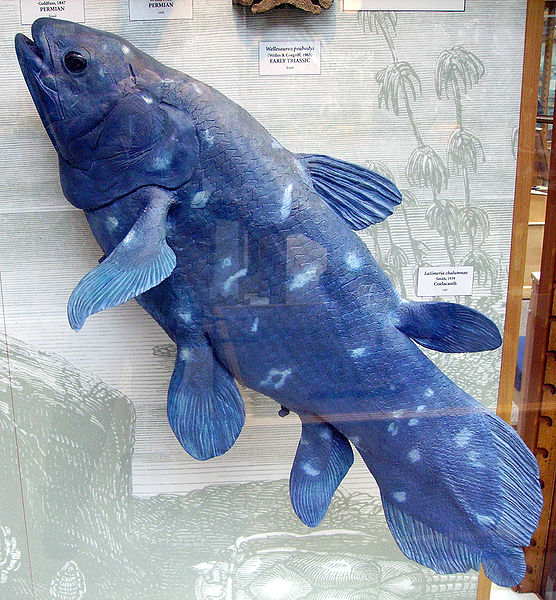Please note: Osher Rainforest will be closed for maintenance Jan. 14–16.
Science News
Secrets from the Coelacanth Genome
April 18, 2013

Some fish keep big secrets. Considered extinct for the last 70 million years, the coelacanth surprised scientists when a fisherman came upon a live one in 1938. These deep-sea fish are examples of “living fossils,” having changed little from their ancestors 300 million years ago, when dinosaurs still roamed the Earth.
Now, an international team of researchers has sequenced the genome of one of the two living species of coelacanths. The results are published in this week’s Nature.
The endangered African coelacanth (Latimeria chalumnae) has more up its sleeve than just the living fossil thing. Scientists have long thought that this group of fishes gave rise to the first four-legged amphibious creatures to climb out of the water and up on land. Lobe-finned fishes (with fins like limbs) are genealogically placed in-between the ray-finned fishes, such as goldfish and guppies, and the tetrapods—the first four-limbed vertebrates and their descendants, including living and extinct amphibians, reptiles, birds, and mammals.
Results from the genomic study place the coelacanths behind lungfish, another lobe-finned living fossil, as the closest fishy relative to tetrapods. But other data from the study still make coelacanths incredibly interesting.
These prehistoric-looking fish are evolving at a very leisurely pace. “We found that the genes overall are evolving significantly slower than in every other fish and land vertebrate that we looked at,” says co-author Jessica Alföldi, of the Broad Institute of MIT and Harvard.
“We often talk about how species have changed over time,” says Kerstin Lindblad-Toh, another co-author from the Broad Institute. “But there are still a few places on Earth where organisms don’t have to change, and this is one of them. Coelacanths are likely very specialized to such a specific, non-changing, extreme environment—it is ideally suited to the deep sea just the way it is.”
Researchers also found several key genetic regions that may have been “evolutionarily recruited” to form tetrapod innovations such as limbs, fingers, and toes, and the mammalian placenta. One of these regions, known as HoxD, harbors a particular sequence that is shared across coelacanths and tetrapods. Tetrapods likely co-opted this sequence from the coelacanth to help form hands and feet.
“This is just the beginning of many analyses on what the coelacanth can teach us about the emergence of land vertebrates, including humans, and, combined with modern empirical approaches, can lend insights into the mechanisms that have contributed to major evolutionary innovations,” says the paper’s lead author, Chris Amemiya of the Benaroya Research Institute.
Image: Ballista/Wikipedia